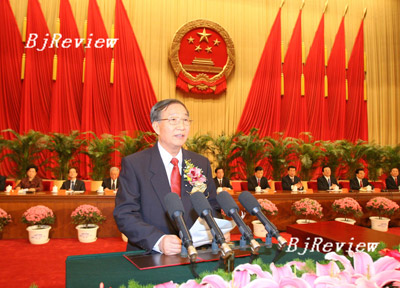
China granted its State Scientific and Technological Award for 2006 Tuesday to scientist Li Zhensheng for his achievements in wheat breeding. Li is the 10th Chinese scientist to win this top award.
Chinese president Hu Jintao, with other senior leaders, presented the top award to Li and other prizes to prominent scientists and enterprises that have made remarkable progress in technological innovation at the annual national science-technology prize awarding ceremony Tuesday.
Li was awarded 5 million yuan (US$600,000) at the ceremony, including 500,000 yuan for himself and 4.5 million for his research.
Li, born in 1931 in east China's Shandong Province, is an academician of the Chinese Academy of Sciences (CAS). He has developed fine strains of wheat through distant hybridization and contributed to China's food security.
"Science and technology plays a fundamental role in the country's modernization process," said Premier Wen Jiabao at the ceremony, adding the working and living conditions of scientists should be improved.
Wen highlighted the importance of strengthening science and technology education in primary and middle schools and encouraging the innovative spirit of students.
The top science prize winner Li successfully developed the fine wheat strain "Xiaoyan No. 6" in 1979 that features drought endurance, heat withstanding and disease resistance. "Xiaoyan" series greatly boosted the country's crop production in following years.
Li has also introduced chromosome engineering to the breeding of wheat strains with a "nullisomic backcross method", which has reduced the duration of wheat breeding through distant hybridization to 3.5 years, whereas the previous breeding of "Xiaoyan" lasted 20 years.
The project of China's third-generation fighter aircraft Jian-10 (Fighter-10) won a top technological progress award.
The fighter aircraft, developed by the China Aviation Industry Corporation I (AVIC I) after seven years of work, marks a breakthrough in China's research and development of heavy fighter aircraft.
With proprietary intellectual property rights (IPR), the Jian-10 heralds the third generation of Chinese fighter aircraft.
Military observers say the Jian-10 can not match the United States' fourth-generation fighter aircraft in performance but its basic design and onboard equipment are comparable to those of mainstream fighter aircraft in the West.
The award winners also included workers and farmers. One employee of Shanghai Baosteel Group, one employee from FAW-VOLKSWAGEN Co. Ltd and an entrepreneurial farmer from central China's Henan Province shared second prize for the technological progress award for technical innovations.
Innovations from private enterprises accounted for more than 30percent of the total number of prize winners.
Che Chi-Ming from Hong Kong University won a first prize for his excellence in the research of metal ions promoted organic transformations. It was the first time Hong Kong scientist won the state science prize.
Senior leaders Zeng Qinghong and Li Changchun also attended the event and presented the awards.
The ceremony was jointly held by the Central Committee of the Communist Party of China and the State Council. More than 3,000 science workers attended the event.
Since the State Scientific and Technological Award was established in 2000, ten Chinese scientists have received the five-million-yuan top award, including atmospheric physicist Ye Duzheng, a liver and gall specialist Wu Mengchao, hybrid rice developer Yuan Longping, mathematician Wu Wenjun and IT expert Wang Xuan.
Last year, China's total R&D spending reached 300 billion yuan (38.5 billion U.S. dollars), an increase of 22 percent over the previous year, which accounted for a record 1.4 percent of the country's gross domestic product (GDP).
The country's R&D spending should reach two percent of the GDP in 2010, according to the 11th Five-Year Plan (2006-2010).
(Source: Xinhua News Agency February 28, 2007)
| 